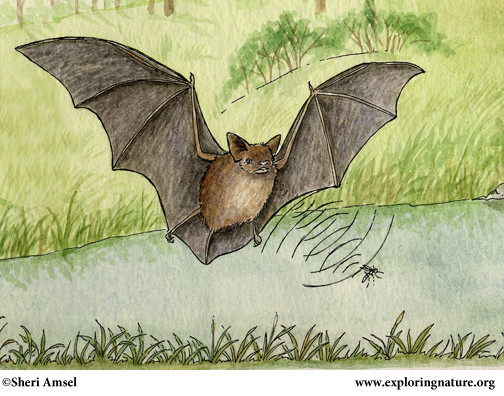

They are found from southern Canada and Alaska, south into the U.S. and in some of the forested mountain regions of Mexico. They are not seen in the extreme southeastern portions of the U.S.
They are found in most habitats, including populated areas where they roost in attics, outbuildings and woodpiles. In the wild, they seem to prefer forested areas near a water source.
They are tiny bats with small ears. Their shiny fur can be a wide range of shades from tan to dark brown and is lighter underneath. They are up to 4” long, weigh less than ½ ounce and have a wingspan of up to 10”. There is a flap of skin that stretched between the legs and tail called the uropatagium.
They are nocturnal, coming out at night to hunt, using echolocation. Echolocation is a kind of radar that uses the bat’s high-pitched calls to bounce off objects. They can actually “see” what is around them by how their calls bounce off their surroundings. During the day they sleep (roost) in groups in the furrowed bark of trees, under porches, bridges and in rock cracks. They can squeeze in very small spaces. They hibernate huddled in big groups in winter when there is no insect prey.
They eat insects – mostly aquatic insects that they catch while gliding over the water after dark
They are preyed upon by birds of prey, like hawks and owls, by raccoons, weasels, and even house cats.
They mate in the fall, but females store the sperm until spring when they become pregnant for about 3 months (gestation). They give birth upright, catching their single pup in the flap of skin that stretches between their legs and tail. They can fly by 3 weeks old and are on their own by a month old.
Can live more than 10 years in the wild, but usually less. They are not a threatened species.
Kingdom: Animalia
Phylum: Chordata
Subphylum: Vertebrata
Class: Mammalia
Order: Chiroptera
Family: Vespertilionidae
Subfamily: Myotinae
Genus: Myotis
Species: Myotis lucifugus
When you research information you must cite the reference. Citing for websites is different from citing from books, magazines and periodicals. The style of citing shown here is from the MLA Style Citations (Modern Language Association).
When citing a WEBSITE the general format is as follows.
Author Last Name, First Name(s). "Title: Subtitle of Part of Web Page, if appropriate." Title: Subtitle: Section of Page if appropriate. Sponsoring/Publishing Agency, If Given. Additional significant descriptive information. Date of Electronic Publication or other Date, such as Last Updated. Day Month Year of access < URL >.
Amsel, Sheri. "Bat (Little Brown)" Exploring Nature Educational Resource ©2005-2024. December 14, 2024
< http://exploringnature.org/db/view/Bat-Little-Brown >

